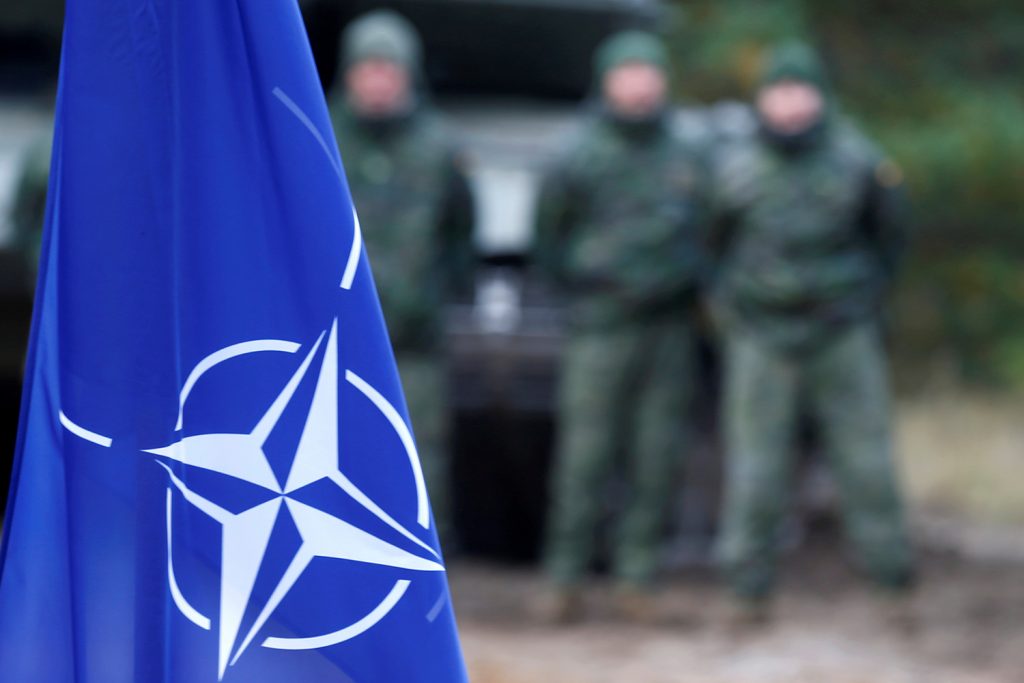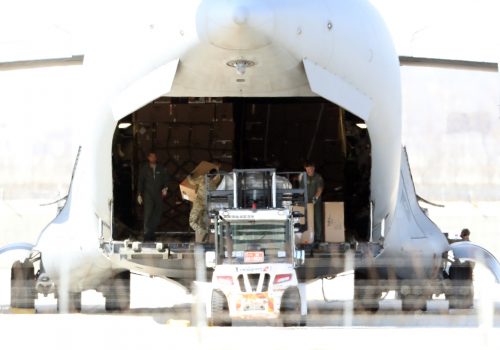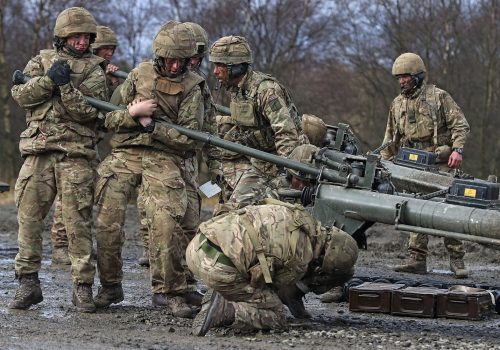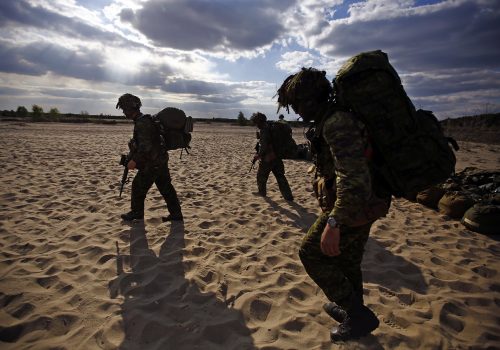June 14, 2021
Three priorities for NATO partnerships in a contested world

The NATO Summit came at a pivotal moment for the Alliance as it adapts to a new security environment shaped by transnational challenges and increasing competition with Russia and, most significantly, China. The challenges associated with China’s rise first surfaced in official NATO documents during the 2019 Leaders Meeting, where allies agreed on the need to respond collectively. Since then, allied positions have hardened considerably as a result of the pandemic, China’s “wolf-warrior diplomacy,” economic coercion, and human-rights abuses. Today’s NATO Summit communiqué outlines China’s “systemic challenge to the rules-based international order and to areas relevant to Alliance security.”
Over the next twelve months, the allies will negotiate a new Strategic Concept that adapts NATO’s core tasks—collective defense, crisis management, and cooperative security—to this contested environment. It will be informed by the NATO 2030 Report, which characterized China as a full-spectrum rival and offered recommendations to strengthen NATO’s political dimensions and extend its global reach. The next Strategic Concept presents an opportunity to breathe new life into cooperative security by steering cooperation with non-member states toward these challenges. NATO should double down on what works—capacity-building—while expanding political consultations with partners and forging new frontiers in science and technology cooperation.
NATO’s Partnerships programs have provided options for cooperation with non-member states for more than twenty-five years. They’ve proven remarkably flexible and adaptable, serving partners’ as well as NATO’s evolving interests. They helped consolidate democratic transitions in Europe, provided support for NATO-led missions and operations, and strengthened collective defense and deterrence. Through Partnerships for Peace, NATO offers a menu of more than 1,400 activities open to all forty partner states around the world. Partners choose the scope, focus, and intensity of their cooperation with NATO. The arrangement has appealed to a diverse group of states, which NATO organized into the Euro-Atlantic Partnership Council, the Mediterranean Dialogue, the Istanbul Cooperation Initiative, and Partners Across the Globe.
In the current environment, however, there is mounting pressure to adapt partnerships to ensure they continue to support NATO’s interests. The patchwork of geographic groupings is increasingly incongruent with today’s challenges. The groups have generally failed to promote security cooperation or political consultations at the regional level. They have also inhibited NATO’s ability to set priorities or steer cooperation with partners towards its own objectives. Moreover, the activities that partner states value most—capacity-building and interoperability, or the ability to link up their forces with NATO’s and act coherently—remain underfunded. As NATO reorients to incorporate China into a broader strategic calculus, how can NATO preserve what works for partners and adapt its partnership policies without defaulting to a one-size-fits-all approach?
Subscribe for events and publications on transatlantic security
Sign up for updates from the Atlantic Council’s Transatlantic Security Initiative, covering the debate on the greatest security challenges facing the North Atlantic Alliance and its key partners.
First, NATO should ensure that capacity-building and additional resilience support remain priorities. China is using its economic leverage to expand its security cooperation, and Beijing, along with Russia, is undermining Alliance credibility. Some partners have become testing grounds for hybrid attacks. Capacity-building helps counter that by strengthening partner institutions and resilience, and a sense of shared security. The Partnership Interoperability Initiative protects hard-earned interoperability with some partners, and the Defence and Related Security Capacity Building (DCB) Initiative already supports Georgia, Iraq, Jordan, Moldova, and Tunisia. The NATO Parliamentary Assembly has recommended more attention to Ukraine, the Western Balkans, and areas with weak institutions or where democracy is undermined. Civil emergency planning through NATO’s Euro-Atlantic Disaster Response Coordination Centre is also valuable.
Capacity-building programs are also a path to NATO interoperability for partners, which remains a major driver for cooperation with NATO—even among neutral countries that may never contribute to a NATO military operation. This is because NATO provides internationally recognizable military standards and the ability to plug-and-play into European Union (EU), United Nations, or other multilateral operations. NATO interoperability certification is in demand among partners, as are its robust programs for education, training, and exercises. These activities promote defense and security sector reform, strengthening institutions and transparency. NATO should work to overcome constraints on partner participation in exercises, especially for Japan, South Korea, Australia, and New Zealand. Cooperative security depends on NATO’s centrality as an international standard-setter, a position that cannot be taken for granted.
Second, NATO should accelerate internal consultations on China and bring partners in early and often on topics of mutual concern, ensuring NATO decision-making is informed by partners in the earliest stages. This has worked well with Sweden and Finland, but it should work better with NATO’s Indo-Pacific partner states, those along China’s Belt and Road Initiative, and those with high-end cyber or space interests. The old geographic boundaries are being redrawn around these issues. NATO should work to better define mutual expectations and goals with partners and leverage natural groupings around cross-cutting challenges, perhaps by expanded use of 30+N arrangements or revised “framework nation” models, to bypass the gridlock of regional mechanisms. Daniel Hamilton of Johns Hopkins’ School of Advanced International Studies recommends offering Enhanced Opportunities Partnerships to Japan and South Korea in an effort to improve interoperability, information-sharing, and political consultation.
Finally, NATO should forge new frontiers in science and technology (S&T) cooperation with partner states and the EU. The Alliance has interests in achieving dominance in Emerging Disruptive Technologies (EDTs) and in setting norms and standards for their incorporation into militaries. NATO boasts renowned research universities and innovation hubs, but so do partner states like Sweden, Finland, Japan, and South Korea, for example. NATO should expand support for S&T collaboration with these partners and others through the Science for Peace and Security Programme (SPS). NATO should also explore other avenues to expand research collaboration with select partners and share lessons learned from public-private partnerships. Partners already stand shoulder-to-shoulder with NATO on cybersecurity, for example, and should be brought into S&T Board and other discussions where possible. A more ambitious NATO-EU relationship in this area would be a force multiplier.
NATO also has a related interest in leading the global mission to ensure that EDTs are integrated into modern militaries in ways that are consistent with its values and with the Universal Declaration of Human Rights and United Nations Sustainable Development Goals. So far, the Alliance’s Advisory Group reports that NATO’s EDT strategies are focused internally on harnessing member states’ strengths and building a cohesive Alliance innovation ecosystem that is buttressed by talent development and novel financing initiatives. NATO is expected to release an artificial intelligence (AI) and big data strategy this summer, the first of seven EDT strategies, and it should outline a broader vision that links NATO’s innovation ecosystem with those of its partners. Partners and other like-minded states around the world are already looking to NATO for guidance on AI, codes of conduct for military activity in outer space, and standard-setting for cybersecurity, for example.
Looking ahead, NATO partnerships will remain demand-driven, but they should adapt to serve NATO as it grapples with China’s rise while still addressing myriad other challenges. The next Strategic Concept will update the Alliance’s approach to cooperative security. NATO should set a higher level of ambition for partnerships and fund them so that they continue to appeal to such a diverse group of states around the world. Expanding capacity-building to include more resilience support remains paramount, but accelerating political consultations and forging ahead with ambitious S&T cooperation are also important. Failure in these areas risks allowing NATO partnerships to languish and fade into irrelevance at a time when the Euro-Atlantic community most needs a wider network of partners to face a contested world order.
Lisa Aronsson is a research fellow, and Brett Swaney is an assistant research fellow, at the Institute for National Strategic Studies at National Defense University. The opinions, conclusions, and recommendations expressed or implied are their own and do not necessarily represent the views of the National Defense University, the Department of Defense, or the US Government.
Further reading

The Transatlantic Security Initiative, in the Scowcroft Center for Strategy and Security, shapes and influences the debate on the greatest security challenges facing the North Atlantic Alliance and its key partners.
Image: NATO heads of state and government look at a digital installation after posing for a family photo during the NATO summit at the Alliance's headquarters in Brussels, Belgium, on June 14, 2021. Photo by Kevin Lamarque/Pool via REUTERS.


